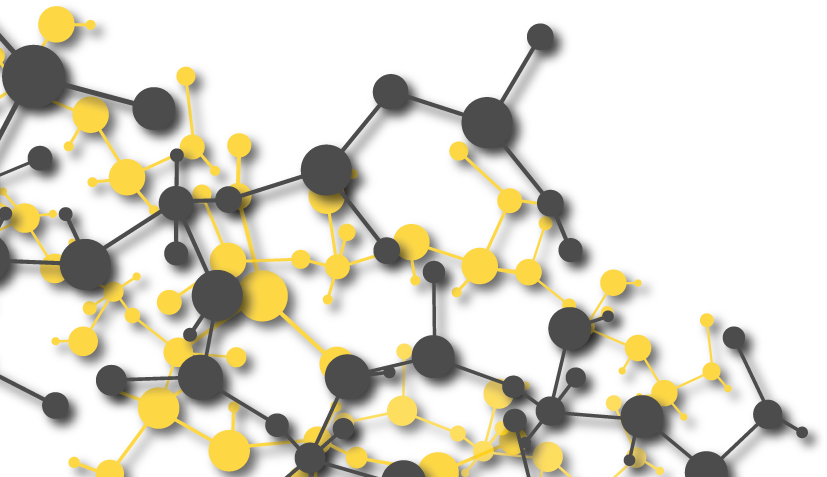The Daicel N-series of polyols, offered worldwide by Gantrade, is a family of Innovative, very narrow molecular weight distribution polycaprolactone polyols. Key features and benefits of this unique low MWD series of polycaprolactone polyols for polyurethanes include the following:
- Outstanding application properties including mechanical properties
- Low viscosities in a prepolymer and TPU
- Higher elastic recovery Better solvent and wear resistance
- Improve adhesive and cohesive strength
- Higher resiliency
- Better low temperature flexibility
- Greater transparency
- Reduced tendency of soft-block crystallization (“cold hardening”)
- Higher solids coatings, lower VOCs and better coating application characteristics
Let’s take a deeper look at some of the performance enhancements achievable in polyurethanes using narrow MWD polycaprolactone polyols.
Definitions of MW Distribution
All synthetic polyols are polydisperse, in that they contain polymer chains of unequal lengths. The broadness of short and long-chain distribution is defined by the molecular weight distribution (MWD), conveniently characterized as the ratio of the weight average (Mw) and the number average (Mn) molecular weights of the polymer. Mn is the average molecular weight of the polyol divided by the total number of repeating polymer molecules, n; Mw is the weighted average of the polymeric chain molecular weights, wherein high molecular fractions contribute to a greater extent to the Mw. Thus, the Mw, which emphasized the contribution of the higher molecular weight fractions, is always a larger value than the Mn.
The larger the polydispersity index, the broader the distribution of the molecular weight fractions. To provide a perspective, a theoretical monodisperse polyol, where all the chain lengths are equivalent, would have an Mw/Mn = 1. The best controlled synthetic polyols (narrow MWDs) have Mw/Mn’s of 1.02 to 1.20. Step polymerization reactions typically yield values of Mw/Mn of around 2.0, whereas condensation reactions yield Mw/Mn values well above 2, e.g., 2.5-3.5. The classical methods to measure the Mw and Mn molecular weight averages use gel permeation chromatography (GPC) and size exclusion chromatography (SEC).
Micro-Molecular Differences in Polyurethanes based on Polyol MWDs
Depicted below are models of the micro-structural differences in polyurethane architectures based on a polyol with a narrow MWD versus. a polyol with a broad MWD. The models best illustrate the features of polyurethanes produced with narrow MWD polyols. The red points represent the association of the hard segments while the yellow lines depict the soft segment microstructures.

The illustration shows a more uniform distribution of the hard block segments associated with a narrow and uniform MWD polyol and the lack of long soft-block segments, which will exhibit a high propensity towards crystallization, viscosity build, and solvent attack. The short segment fractions of a wide MWD polyol are less effective in the development of resiliency, low temperature performance, and elastic recovery among other attributes sought in a polyurethane.
What Makes Polycaprolactone Polyols Unique in Polyurethanes?
Polycaprolactone polyols comprise a special class of aliphatic polyester polyols. The polycaprolactone polyols are created by a ring-opening polymerization process (ROP) under mild-conditions without the involvement of acidic moieties, as depicted in the chemistry below. The polycaprolactone polyols can be produced with very low acid values (increasing hydrolytic stability); perfect end-termination functionality (delivering excellent reactivity and high MWs); narrow molecular weight distributions (achieving low viscosity, etc.) and using a wide variety of initiator molecules that empower the design of customized features.
%20.gif?width=893&name=polycaprolactone%20polyols%20are%20created%20by%20a%20ring-opening%20polymerization%20process%20(ROP)%20.gif)
See our article on Caprolactone Monomer for a greater description of the process known as ROP.
Placcel N Series: Narrow MWD diols
Placcel N diols were developed with a narrow degrees of polydispersity. The significant reduction in polydispersity, demonstrated in the table and GPC curves below, results in superior dynamic properties and the other attributes delineated above. The superior dynamic properties are especially useful in polyurethane high-speed wheels and roller applications, to name a couple of application examples.

The commercial series of N-grade polycaprolactone polyols include Placcel 210N, 220N and 230N (EG initiated), as well as grades of Placcel UA (DEG initiated), Placcel CPT (NPG initiated) and BT (butanediol initiated, as summarized below.

Properties of Cast Polyurethanes based on Placcel 220N
In the table below, we compare Placcel® 220N, a 2000 MW EG initiated narrow MWD polyol, with Placcel CD 220, an HDO polycarbonate diol, in a cast MDI polyurethane formulation, BDO chain extended. We used the 2000 MW polycarbonate diol as a comparison, because the CD diols are a premier performance polyol in polyurethanes, albeit at a much high cost. We made the comparisons at the same compositional hard segment content (Samples 1 and 2) and at the same Shore A Durometer (Samples 2 and 3). Both Placcel 220 elastomers (Samples 1 and 3) exhibited higher tensile strengths, elongations, rebound resiliencies, elastic recoveries, and a much lower Tg.
Within the same hardness values, the Placcel 220N elastomer showed superior elongations, elastic recovery, resiliency, tear strength, and compression set values. The Placcel CD220 exhibited a higher Shore A hardness at the same hard block content and better abrasion resistance.
Comparative Properties of Placcel 220N vs. CD 220-based CPUs
| Sample | 1 | 2 | 3 | Method |
| PCL-MDI-BDO 1:3.5:2.4 |
PCD-MDI-BDO 1:3.5:2.4 |
PCL-MDI-BDO 1:4.5:3.3 |
||
| Hard Segment | 35.2 | 35.2 | 41.6 | |
| Hardness (A) | 85 | 89 | 89 | ISO 7619-1 |
| Tensile Strength, MPa | 43.2 | 42.2 | 47.0 | ISO 37 |
| Elongation, % | 465 | 329 | 481 | ISO 37 |
| Tear Strength, KN/m | 87.9 | 89.1 | 94.0 | ISO 34 |
| Compression set (72h/70°C), % | 26.3 | 26.0 | 18.7 | ISO 815-1 |
| Rebound Resilience, % | 65.4 | 44.8 | 60.8 | ISO 4662 |
| Elastic Recovery, % | 61.7 | 26.7 | 62.6 | * |
| Abrasion, mg | 35.4 | 25.8 | 28.8 | ISO 4649 |
| Glass-Transition, °C | -27.9 | 7.3 | -23.9 | DSC |
Elastic recovery was measured by stretching samples to 300 percent elongation at a deformation rate of 500 mm/min., followed by recovery measurements after 10 minutes from the release of the stress.
Properties on TPUs based on Placcel N Grades
The narrow MWD Placcel N series of polyols offers several performance benefits in the design of thermoplastic elastomers (TPUs). These benefits include greater transparency and light transmission, low compression set properties, excellent elastic recovery, and very good high and low temperature performance. These benefits are of course in addition to the other attributes of the polycaprolactone class of polyols. The table below compares TPU properties for three molecular weight grades of Placcel N, 1000, 2000, and 3000 MW diols.
The greater transparency afforded by the narrow MWD polyols, in combination with their improved resistance and mechanical properties, are beneficial in protective film applications. These include transparent interlayer film, paint protective film (PPD), safety glazing, and surface protection film applications where excellent durability, abrasion and scratch resistance, oil and solvent resistance, and UV resistance are also required. As evidenced in the data below, some crystallization of the polycaprolactone chain does occur as the polyol extends to a 3000 MW, where a drop-off in light transmission and elastic recovery can be seen. The graph of transparency provides a profile of the percent light transmission against the wavelength of light.
The standout features of the three MW grades in the table below include the following:
- 210N: Outstanding transparency, good elastic recovery, reduced cold hardening, and high tear strength
- 220N: High elongation, low compression set, and good elastic recovery
- 230N: Good high and low temperature performance and high tensile strength
The glass transition temperature TPUs are -21, -38 and -49 °C, respectively for the three TPU based on Placcel 210N, 220N and 230N, by DSC.
Basic Properties of TPUs Based on Placcel N Grades


Conclusion
Placcel N diols have been commercialized with narrow MWDs. The significant reduction in polydispersity, results in superior dynamic properties, excellent elastic recovery and resiliency properties, high transparency and light transmission, and the other attributes outlined above. The superior dynamic properties are especially useful in polyurethane high-speed wheels and roller applications, to name a pair of use cases. The greater transparency afforded by the narrow MWD polyols is beneficial in transparent interlayer film, paint protective film (PPD), safety glazing, and surface protection film applications where excellent durability, abrasion and scratch resistance, oil and solvent resistance, and UV resistance are required.
To understand which polyol is best suited for your unique needs, partner with Gantrade. We are a global leader in the distribution of high-performance polyols for a variety of performance enhancements for multiple industry applications. Our team’s wealth of technical knowledge and expertise,along with our uncompromising standards for customer service, ensure that you will receive the best polyurethane solutions for applications. Gantrade’s urethane platform of specialty polyols, chain extenders and curatives provide a broad range of possibilities to achieve your high-performance polyurethane requirements. Our global supply chain means high-quality chemical products where you need them, when you need them. Contact Gantrade today to learn more.
















